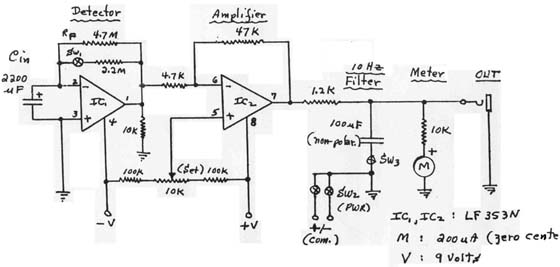Impulse Gravimeter Circuit #1500
( 3-12-1990 )
Introduction:
Impulse Gravimeter Circuit #1500 was fabricated in a plastic box 1.5" x 2.5" x 5" in size but with an aluminum cover plate. All operating controls are brought out on this panel, as well as an output jack and a small (1.5" square) tuning-type meter used to give an indication of the output pulses developed by this unit. The unit was primarily designed to demonstrate the gravitational ‘impulses’ and ‘shadows’ generated by the numerous Newtonian-type gradients developed in this universe.
Figure (1): Impulse Gravimeter Circuit #1500

Notes:
(1) Meter is approx +/- 1.5 volts;
(2) Meter as obove reads impulses; place 470 uF to 21,000 uF capacitor (or higher!) across input for use as g-field gravimeter;
(3) Meter will read up or down scale for increase in g-field, depending on which side of zero scale the off-set is placed;
(4) Detector sensitivity (Gain) is controlled with SW1 for high or low gain;
(5) SW2 is on-off; SW3 is filter on-off.
The Circuit:
The circuit used in this unit is a typical electronic-type gravimeter but has had the parameters adjusted for this particular application. The detector section (IC1) is typical, but the sensing capacitor, Cin, and the feedback resistance, Rf, have been made very large to: (1) increase the basic sensitivity (gain) for the unit, and (2), to keep the input resonances very much below 1 Hz, so as to avoid the many ELF ‘resonances’ seen in the universe. Two levels of sensitivity (gain) are available with the switch, SW1.
The output of the detector is fed directly to an amplifier stage (IC2) having a gain of about 10x. The ICs are J-FET input op-amps with high slew rates and input impedances and thus are well-suited for this application. An off-set control is included to enable the shifting of the unit’s operating point to either side of the zero unit. This enables operation of the unit with a choice of pulse polarity, e.g., the negative mode of operation will allow an increase in the detected value of the earth’s g-field to read up-scale on the meter.
The internal low-pass filter is fixed at about 10 Hz in the cut-off frequency for a good response to the gravitational signals from the Local Supercluster Group of Galaxies, as well as our own Milky Way Galaxy. This filter can be cut out if you wish to follow the more remote events in the universe. The built-in 1.5 volt voltmeter (a tuning meter) is not calibrated, but is used to determine the proper operating point and levels for use with an external calibrated meter, a strip chart recorder, or even a computer unit.
Operation:
Operation of this unit is quite simple: Turn on the power supply and allow the unit a minute or so to stabilize. Set the off-set control to its mid-position. Place the sensitivity (gain) control to its low position and the filter to its off position. The gravitational signals should be quite apparent as fairly rapid meter excursions. Switch the gain control to its high position and the excursions should now be more pronounced. The actual output voltages may now be read on an external voltmeter or the strip chart recorder unit. Use the off-set control to properly position the response on the meter or the recorder unit. The output polarity can be reversed with the of-set control or by actually exchanging the output leads. The experimenter should become adept at using this unit in very short order.
Conclusions:
While this unit was primarily intended for response to fairly rapid ‘universe’ gravitational responses, it may also be used as a g-factor gravimeter by loading the output with a capacitor of about 21,000 uF to 100,000 uF, to increase the output time constant to such a long time that the unit would respond only to the very slow changes in the earth’s g-field levels. With the judicious selection of the operating parameters it should be possible to set the unit to a reading of (32) on the meter scale and have this conform to the value of 32 ft/sec2, or possibly (98) to conform to the value of 980 cm/sec2 . The unit can thus be made into a direct reading gravimeter for many purposes. This type of operation will disclose to the experimenter the subtle changes in the earth’s gravity which are affecting our weather patterns!
While the current requirements for this unit are low, for best results the experimenter should ensure that ‘good’ batteries are used. This unit is a good introduction to the new field of gravitational astronomy. Good experimenting to all!